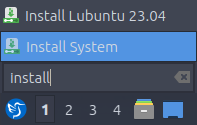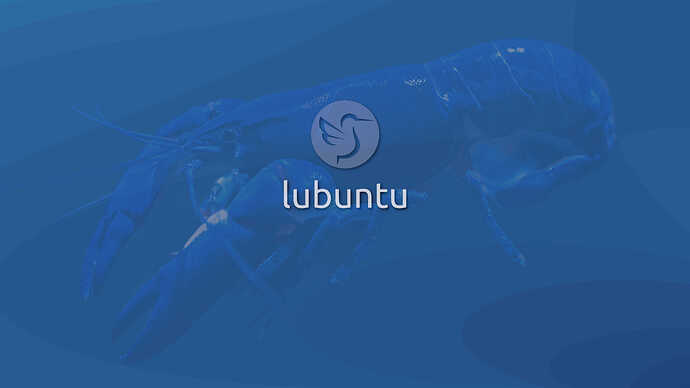An up-to-date and official copy of the release notes can be found here
Lubuntu 23.04 Released!
After months of clawing our way through development, testing, and bug fixing, the Lubuntu team is thrilled to shell-ebrate another successful release cycle! We’ve finally pinched a working copy of the Lubuntu operating system, and it’s our biggest catch yet: Lubuntu 23.04 Lunar Lobster, the 24th release of Lubuntu and the tenth to feature LXQt as its default desktop environment. So let’s all shell-ebrate with some Lunar Lobster puns!
Support lifespan
With 23.04 being an interim release, it will follow the standard non-LTS support period of nine months; this means that 23.04 will be supported until January 2024. Our development focus going forward will be on 23.10 and future releases, so only critical bugfixes and security updates will be provided. If you choose to use 23.04, we STRONGLY recommend upgrading to 23.10 once it is released, before 23.04 hits end of life. If this is not suitable for you, but you still enjoy new features on a regular basis, we would recommend staying on 22.04 LTS with Lubuntu’s Backports enabled.
You can download 23.04 here. If you would like to upgrade your existing 22.10 installation, please visit our manual page describing the process. Common Ubuntu instructions can be found here.
Known Issues and Notable Changes
LXQt
A bug in LXQt results in duplicate menu entries for the Calamares installer, showing the following:

While either of these options work, we recommend using the desktop icon.
While LXQt 1.3.0 has already been released at this time, it was released after Lubuntu 23.04’s Feature Freeze. As a result, Lubuntu 23.04 ships with LXQt 1.2.0 with 1.2.1 point releases updates for a few components. We intend to ship LXQt 1.3.0 or later with Lubuntu 23.10. LXQt 1.3.0 will also be backported to Lubuntu 22.04 LTS if possible.
System Installer
In Lubuntu 22.10, we chose to ship an (at the time) very recent alpha testing version of the Calamares installer, Calamares 3.3 Alpha 2. This worked quite well, and over the past several months Calamares 3.3 has been battle-tested by our developers, our testing team, and our users of Lubuntu 22.10, with no high-impact bugs discovered in Calamares itself. We have therefore chosen to continue shipping Calamares 3.3 Alpha 2 in Lubuntu 23.04.
During testing, we did note that if you attempt to create an encrypted installation without a passphrase, Lubuntu will be installed unencrypted. This is unlikely to be a problem for most users as disk encryption requires a passphrase for it to be effective. More information can be found here.
User password requirements
During testing, we discovered that it was possible to instruct Calamares to create the initial user account with a blank password. This was not the result of a bug in Calamares, but was rather due to incorrect configuration in Lubuntu. Due to the security implications of this, and because of a bug in XScreenSaver that could result in the user being locked out if the password is blank, we have chosen to require that some password be provided during the installation process, even if that password is only one character long. More details can be found in the official bug report.
If you fully understand what you are doing and do not want a password, there are several ways of disabling most or all password-based authentication in Lubuntu. These methods are documented on our Discourse forum here. We highly recommend that most users do not remove or otherwise disable their system’s password for security reasons.
PipeWire
Lubuntu previously used the PulseAudio audio system to provide rich audio functionality to our users. However, recently Ubuntu and its flavors have been gradually shifting to using the PipeWire audio server in place of PulseAudio. PipeWire offers several advantages over PulseAudio, including improved Bluetooth support, and more powerful management features for complex audio-related workloads. In order to offer these improved features to our users, Lubuntu has replaced the PulseAudio audio system with PipeWire in Lubuntu 23.04.
Screensaver
Since Lubuntu 20.04, the default screensaver has been “Flurry”. Due to reports of screensaver glitches on certain hardware, we have switched the default screensaver in Lubuntu to GL Matrix. This screensaver features a 3D “digital rain” effect that we have found to be aesthetically pleasing. If you have changed the screensaver yourself, you will probably not notice this change. If you find the new screensaver unappealing, you can change it back to the original “Flurry” screensaver (or to any of the other pre-installed screensavers) using the Screensaver application.
Picom
Lubuntu 22.10 and earlier run with no X compositor by default. (An X compositor is an application that can help provide various graphical effects and possibly smooth out screen tearing.) For those who benefited from X compositing, the Compton compositor was provided. We began also providing the Picom compositor (which is based on Compton but is more well-maintained) in Lubuntu 21.04. Starting with Lubuntu 23.04, we have switched entirely to Picom, and have enabled X compositing by default. This will allow effects like panel transparency to work out of the box rather than requiring that the compositor be manually enabled.
If you discover that X compositing is causing problems for you, or if you are experiencing significantly more screen tearing than in previous versions of Lubuntu, you can turn X compositing off by going to the Application Menu → Preferences → LXQt Settings → Session Settings. You can then find and uncheck the “Picom (X compositor)” entry under “LXQt Modules”, and then click “Close”. X compositing should be disabled the next time you log in.
Artwork
We have refreshed the wallpaper, the default background for the login screen, the installer welcome image, and the installer slideshow for Lubuntu 23.04. This updated artwork was provided by one of our Lubuntu Members, Aaron Rainbolt.
Common Release Notes
Please also check the Ubuntu Release Notes for more common issues and bugs affecting all Ubuntu flavors.
What is Lubuntu?
Lubuntu is an official Ubuntu flavor which uses the Lightweight Qt Desktop Environment (LXQt). The project’s goal is to provide a lightweight yet functional Linux distribution based on a rock-solid Ubuntu base. Lubuntu provides a simple but modern and powerful graphical user interface, and comes with a wide variety of applications so you can browse, email, chat, play, and be productive. You can find the following major applications and toolkits installed by default in this release:
- LXQt 1.2.0
- Qt 5.15.8
- Mozilla Firefox as shipped in the snap package, the version present on the ISO is version 111.
- LibreOffice 7.5
- VLC 3.0.18
- Featherpad 1.3.5
- Discover Software Center 5.27.3
You can find a variety of other applications installed which aim to enhance your experience while staying out of the way of your normal workflow. New features and bugfixes in core Ubuntu components can be found here.
Lubuntu Manual
The Lubuntu Team has been hard at work in polishing the Lubuntu Manual to make it easy for new and experienced users alike to use their system more productively. The manual can be found at manual.lubuntu.me. We want to thank Lyn Perrine for all the hard work she has put into the Lubuntu Manual. Thank you!
Versions of the Lubuntu Manual:
- Stable for Lubuntu 23.04.
- LTS for Lubuntu 22.04 LTS.
- Development (always WIP)
While the documentation for previous releases will be kept in the Git repository, they will not be published anywhere.
Need help quickly? The Lubuntu Manual can be accessed via the “Lubuntu Manul” desktop icon.
Lubuntu Project
How can I help?
We can always use more help! No matter your skill level or your technical experience, there’s something you can help with that can make a huge difference in Lubuntu. Join us on our chat (which is bridged three ways to Matrix, Telegram, and IRC) and talk to us there. Whether you know another language, have some spare time to help us test Lubuntu, are good at writing documentation, or just want to stay “in the know,” that is the place to be. More information about contributing can be found here. If you want to contribute to Lubuntu but do not feel you have the time or skills, consider buying a t-shirt or donating to Lubuntu. Another great method to get involved is bug reporting. If you notice an issue, please file a bug using the instructions on the Lubuntu Wiki. Don’t want to file a bug? Let us know what the problem is (in detail, enough that we can reproduce it) and we can assist you in filing one or do it ourselves.
Contributors
We would like to thank the following contributors for dedicating their time to Lubuntu this cycle. Thank you!
- Simon Quigley
- Aaron Rainbolt
- Lyn Perrine
- Dan Simmons
- Chris Guiver
- Thomas Ward
- Rober
- sudodus
- Leó Kolbeinsson
- KGIII
- Rik Mills
- Erich Eickmeyer
- Many more contributors!
We would also like to thank the following past members for their dedication to the project. Without you, Lubuntu would not be what it is today. Thank you!
- Julien Lavergne
- Rafael Laguna
- Walter Lapchynski
- Raman Sarda
- Hans P. Möller
- And many more!
Global Team
The Lubuntu Global Team has been created to foster communities in non-English languages and locales. An up-to-date list of our communities can be found on our Links page, but the existing groups include: Spanish, Portuguese, Russian, Italian, Chinese, German, Japanese, Arabic, and French. If you would like to start a language group, join our development channel and talk with the Global Team. At minimum, you should have a few interested drivers of the community, and at least one administrator that speaks English. We now have multiple languages available in the support section of our Discourse forum.

